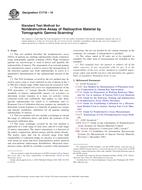Potřebujeme váš souhlas k využití jednotlivých dat, aby se vám mimo jiné mohly ukazovat informace týkající se vašich zájmů. Souhlas udělíte kliknutím na tlačítko „OK“.
ASTM C1718-10
Standard Test Method for Nondestructive Assay of Radioactive Material by Tomographic Gamma Scanning
Automaticky přeložený název:
Standardní zkušební metoda pro nedestruktivní testu radioaktivních materiálů tomographic Gamma skenování
NORMA vydána dne 1.1.2010
Informace o normě:
Označení normy: ASTM C1718-10
Poznámka: NEPLATNÁ
Datum vydání normy: 1.1.2010
Kód zboží: NS-12292
Počet stran: 13
Přibližná hmotnost: 39 g (0.09 liber)
Země: Americká technická norma
Kategorie: Technické normy ASTM
Kategorie - podobné normy:
Anotace textu normy ASTM C1718-10 :
Keywords:
ICS Number Code 13.030.30 (Special wastes), 17.240 (Radiation measurements), 27.120.30 (Fissile materials and nuclear fuel technology)
Doplňující informace
| Significance and Use | ||||||||||||||||
|
The TGS provides a nondestructive means of mapping the attenuation characteristics and the distribution of the radionuclide content of items on a voxel by voxel basis. Typically in a TGS analysis a vertical layer (or segment) of an item will be divided into a number of voxels. By comparison, a segmented gamma scanner (SGS) can determine matrix attenuation and radionuclide concentrations only on a segment by segment basis. It has been successfully used to quantify 238Pu, 239Pu, and 235U. SNM loadings from 0.5 g to 200 g of 239Pu (5, 6), from 1 g to 25 g of 235U (7), and from 0.1 to 1 g of 238Pu have been successfully measured. The TGS technique has also been applied to assaying radioactive waste generated by nuclear power plants (NPP). Radioactive waste from NPP is dominated by activation products (for example, 54Mn, 58Co, 60Co, 110mAg) and fission products (for example, 137Cs, 134Cs). The radionuclide activities measured in NPP waste is in the range from 3.7E+04 Bq to 1.0E+07 Bq. Some results of TGS application to non-SNM radionuclides can be found in the literature (8). The TGS technique is well suited for assaying items that have heterogeneous matrices and that contain a non-uniform radionuclide distribution. Since the analysis results are obtained on a voxel by voxel basis, the TGS technique can in many situations yield more accurate results when compared to other gamma ray techniques such as SGS. In determining the radionuclide distribution inside an item, the TGS analysis explicitly takes into account the cross talk between various vertical layers of the item. The TGS analysis technique uses a material basis set method that does not require the user to select a mass attenuation curve apriori, provided the transmission source has at least 2 gamma lines that span the energy range of interest. A commercially available TGS system consists of building blocks that can easily be configured to operate the system in the SGS mode or in a far-field geometry. The TGS provides 3-dimensional maps of gamma ray attenuation and radionuclide concentration within an item that can be used as a diagnostic tool. Item preparation is limited to avoiding large quantities of heavily attenuating materials (such as lead shielding) in order to allow sufficient transmission through the container and the matrix. |
||||||||||||||||
| 1. Scope | ||||||||||||||||
|
1.1 This test method describes the nondestructive assay (NDA) of gamma ray emitting radionuclides inside containers using tomographic gamma scanning (TGS). High resolution gamma ray spectroscopy is used to detect and quantify the radionuclides of interest. The attenuation of an external gamma ray transmission source is used to correct the measurement of the emission gamma rays from radionuclides to arrive at a quantitative determination of the radionuclides present in the item. 1.2 The TGS technique covered by the test method may be used to assay scrap or waste material in cans or drums in the 1 to 500 litre volume range. Other items may be assayed as well. 1.3 The test method will cover two implementations of the TGS procedure: (1) Isotope Specific Calibration that uses standards of known radionuclide masses (or activities) to determine system response in a mass (or activity) versus corrected count rate calibration, that applies to only those specific radionuclides for which it is calibrated, and (2) Response Curve Calibration that uses gamma ray standards to determine system response as a function of gamma ray energy and thereby establishes calibration for all gamma emitting radionuclides of interest. 1.4 This test method will also include a technique to extend the range of calibration above and below the extremes of the measured calibration data. 1.5 The assay technique covered by the test method is applicable to a wide range of item sizes, and for a wide range of matrix attenuation. The matrix attenuation is a function of the matrix composition, photon energy, and the matrix density. The matrix types that can be assayed range from light combustibles to cemented sludge or concrete. It is particularly well suited for items that have heterogeneous matrix material and non-uniform radioisotope distributions. Measured transmission values should be available to permit valid attenuation corrections, but are not needed for all volume elements in the container, for example, if interpolation is justified. 1.6 The values stated in SI units are to be regarded as standard. No other units of measurement are included in this standard. 1.7 This standard does not purport to address all of the safety concerns, if any, associated with its use. It is the responsibility of the user of this standard to establish appropriate safety and health practices and determine the applicability of regulatory limitations prior to use. |
||||||||||||||||
| 2. Referenced Documents | ||||||||||||||||
|
Doporučujeme:
EviZak - všechny zákony včetně jejich evidence na jednom místě
Poskytování aktuálních informací o legislativních předpisech vyhlášených ve Sbírce zákonů od roku 1945.
Aktualizace 2x v měsíci !
Chcete vědět více informací? Podívejte se na tuto stránku.




 Cookies
Cookies
